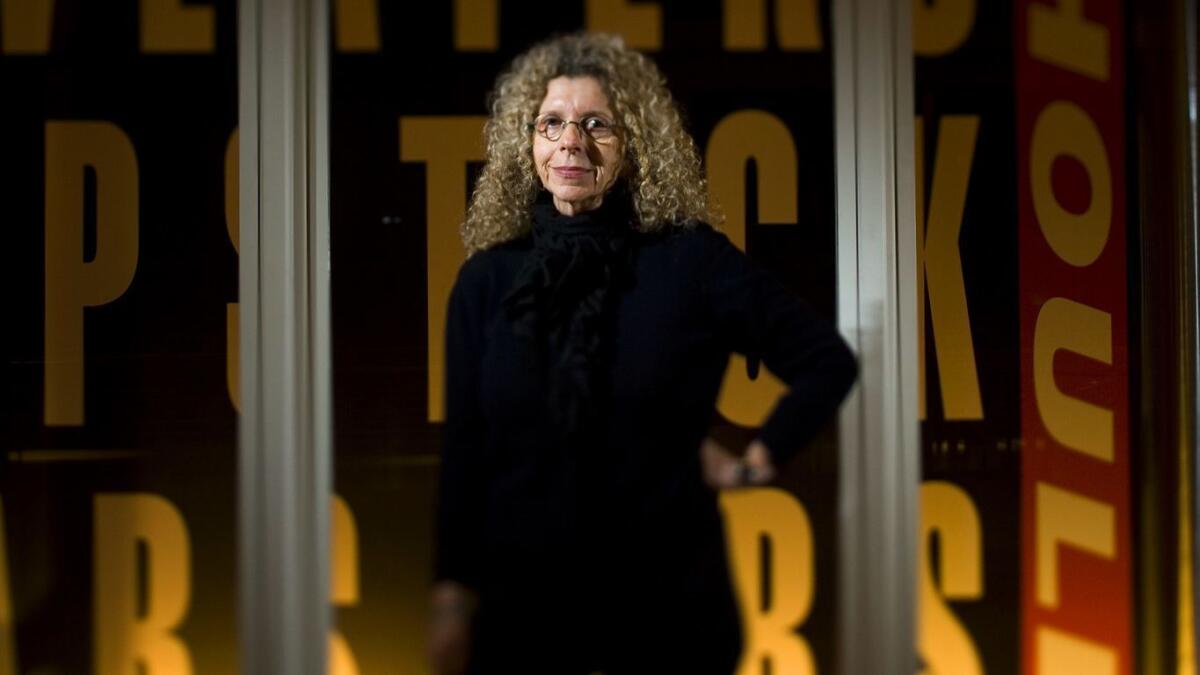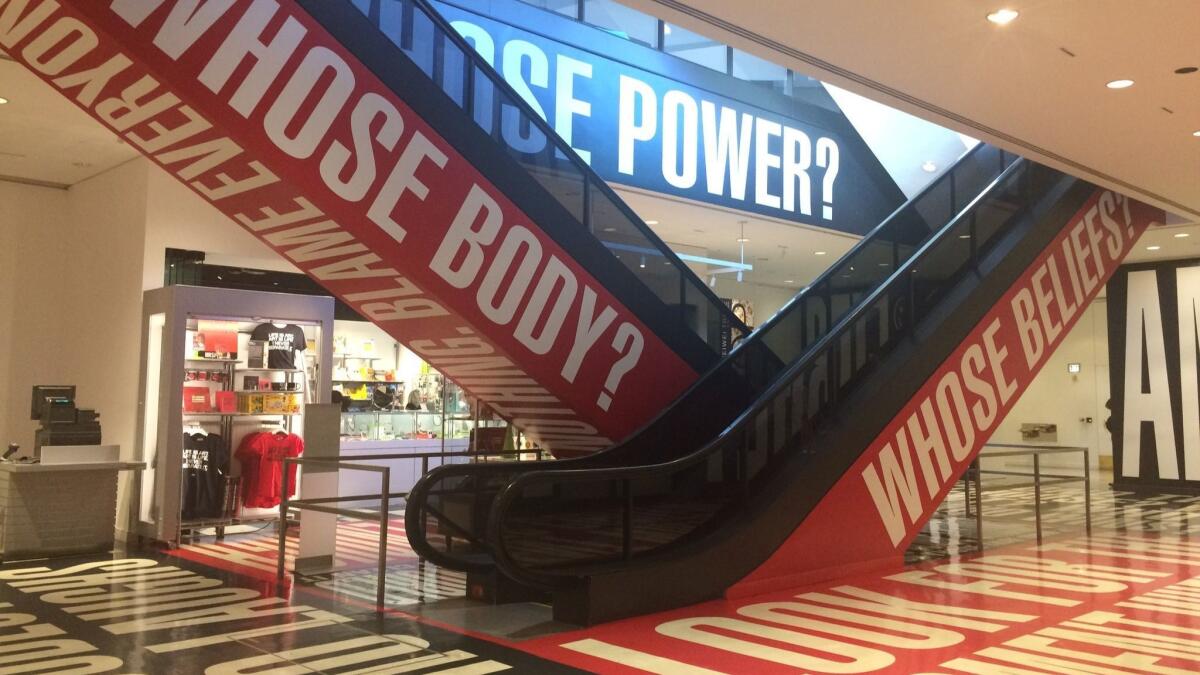In advance of the midterms, Barbara Kruger reprises MOCA mural that asks ‘Who is beyond the law?’
- Share via
There are more iconic years: 1945, which marked the end of a world war, and 1968, with its roiling protest movements. But 1990 also marked an important social and political moment. The Soviet Union was falling apart. HIV became one of the top 10 causes of death in the United States. And the U.S. was heading toward a war with Iraq — the first one, led by President George H.W. Bush.
“It was Bush 1 and everyone was wearing flags,” recalls artist Barbara Kruger. “And, omigod, the war. It was just horrific.”
It was in that climate that the artist painted a mural on the south facade of what was then known as the Temporary Contemporary, the Little Tokyo branch (now known as the Geffen Contemporary) of the Museum of Contemporary Art Los Angeles. The nearly three-story-high mural, in ways both oblique and direct, tackled issues of power, corruption, gender and race.
In its design, the mural “Untitled (Questions)” was inspired by the U.S. flag. Except that in lieu of stripes, it featured nine questions rendered in grab-you-by-the-eyeballs capital letters: “WHO IS BEYOND THE LAW? WHO IS BOUGHT AND SOLD? WHO IS FREE TO CHOOSE? WHO DOES TIME? WHO FOLLOWS ORDERS? WHO SALUTES LONGEST? WHO PRAYS LOUDEST? WHO DIES FIRST? WHO LAUGHS LAST?”
The piece remained in place for two years — well into 1992, when it served as backdrop to the Los Angeles riots. During that uprising, Los Angeles photographer Gary Leonard famously captured a group of National Guardsmen walking along Alameda Street in front of Kruger’s mural. It made her questions seem all the more urgent.
It stands for MOCA, its history and role in the city. It encourages us to engage...It shows us how an artist can create a timeless, unafraid truth.
— Incoming MOCA director Klaus Biesenbach
Kruger is now reprising the work in advance of the midterm elections — this time on MOCA Geffen’s north facade.
On Tuesday morning, her ash-blond curls float in the breeze as she surveys the large-scale letters that are beginning to materialize on the Temple Street side of the building. The questions they so forcefully ask remain strikingly relevant. Of that, she says, “It’s tragic and sad that there is still resonance on these issues.”
The new version of “Untitled (Questions)” is expected to be completed by this weekend and will remain on view through the presidential election in 2020. It will be accompanied by a series of voter registration efforts led by the museum. And it is the first initiative undertaken by new MOCA director Klaus Biesenbach, who starts his job in an official capacity on Monday.
The work, he states via text message, “comes to mind as one piece that, in a way, stands for MOCA, its history and role in the city. It encourages us to engage and mobilize to participate. It shows us how an artist can create a timeless, unafraid truth, and beauty that does not age.”
Certainly, MOCA has special resonance for Kruger, the L.A.-based artist known for bold, graphic works, often rendered in a palette of red, white and black, that play with the tropes of mass media to deliver punchy political messages. Among her most famous pieces is a 1989 work that features a photographic image of a young woman’s face split between positive and negative, bearing the phrase “Your body is a battleground.” (It is on view at the Broad museum.)
Kruger, who was born in Newark, N.J., but has been hanging out in L.A. for teaching gigs since the late 1970s and moved here in 1990 (she’s on the faculty at UCLA), has a long trajectory with MOCA. For starters, she was at the debut show in 1983: an exhibition of painting and sculpture titled, easily enough, “The First Show.” This was in the days when MOCA’s formal Grand Avenue location did not yet exist and all exhibitions were held at the Temporary Contemporary, an old warehouse that had once housed police cruisers and was repurposed as an exhibition space by Frank Gehry.
“People in this city didn’t realize what a gem this building was,” she says. “It was able to shape-shift and be altered in brute, really material ways. It wasn’t a precious over-designed museum.”
MOCA has been important to Kruger in more direct ways too. In 1999, the museum held the artist’s first major museum retrospective. “I had never been asked to do a show on this scale before,” she notes. “It changed my life to be able to have this space.”
She has also served on the museum’s board of trustees — from 2008 until 2012, when she resigned during the tumultuous directorship of Jeffrey Deitch. The museum has since weathered another spate of troubles, including the recent firing of curator Helen Molesworth and the departure of director Philippe Vergne, but Kruger says she feels “hopeful” about MOCA’s future under Biesenbach.
“I think this is a great trajectory for him and for Los Angeles,” she says.

It’s tragic and sad that there is still resonance on these issues.
— Barbara Kruger
With “Untitled (Questions),” Biesenbach is resurfacing a work that is intimately connected with the museum’s history. Though, when it was first proposed, it was not without controversy.
Kruger’s original design featured the Pledge of Allegiance surrounded by her questions. But community groups in Little Tokyo took issue with the work. The mural faced the spot where tens of thousands of Japanese Americans were shipped off to internment camps during World War II. And in those camps, internees were forced to recite the Pledge of Allegiance.
The dialog with the community, she says, was a process that she welcomed. And it resulted in an alteration to her design: there would be no Pledge, only questions.
“The questions were always on the work,” she says. “This never appeared as a pledge without those questions. I don’t think irony is that powerful.”
In his review of the work in 1990, Times art critic Christopher Knight described it as a “huge and startling painting,” one in which the viewer is “pointedly addressed as an active participant in disputatious public life.”
In many ways, the reprise of Kruger’s mural reflects what has changed and what hasn’t in the nearly three decades since Kruger first painted it.
The greatest shift has perhaps occurred within the media landscape, which Kruger, a self-professed “news junkie,” follows closely. The unifying effect of a single newscast or newspaper has been replaced by a fragmented echo chamber of partisan cable news shows, Twitter feeds and conspiracy sites. Moreover, people often experience life through the screen of their smartphones — often with themselves in the frame.
“What’s the importance of that tchotchke on the wall if we’re not standing in front of it?” says Kruger. “This is not a criticism; it’s an observation. It’s how our approach to culture has changed. It makes us so vulnerable to manipulation. When the camera becomes mirror of choice, you lose sight of the big picture.”
In addition, technology has made it easier than ever to produce images and disseminate them. The types of text-and-image collages that Kruger once painstakingly created by harvesting graphics from old books — “I remember looking for images in the used bookstores on Sawtelle,” she notes — can now be manufactured in seconds on a meme-making website.
Kruger’s work, as a result, has also evolved — often jumping off the wall into installations that respond to architecture.

This includes a long-term installation at the Hirshhorn Museum in Washington, D.C., which wraps every imaginable surface of the basement area (escalators included) in words, as well as a dramatic piece for a freight elevator at the Los Angeles County Museum of Art. The latter features a dire quote by George Orwell — “If you want a picture of the future, imagine a boot stomping on a human face forever” — paired with an image that shows the bottom of a man’s shoe.
These types of architectural interventions will be at the heart of a major new survey of the artist’s work being organized by the Art Institute of Chicago for the fall of 2020.
“There is no bad space,” says Kruger of working three-dimensionally. “People say, ‘I can’t do this. This is a bad space.’ No, it’s a challenge.”
Curiously, the one thing that hasn’t changed much since Kruger first painted her mural in the summer of 1990 are the issues that spurred it. Who has sovereignty over women’s bodies? Who is most disenfranchised by the prison industrial complex? How is religion deployed in civic life? These are all issues we continue to debate … hotly.
With her own questions, Kruger hopes she might spur some alternate thoughts.
“It’s creating commentary about living another day,” she says. “How the world could be and isn’t.”
ALSO
Artist Barbara Kruger turns a bland building into a screaming statement. Time to listen up
A to-do list for MOCA’s new director, Klaus Biesenbach
A MOCA retrospective of Barbara Kruger’s work asks provocative questions about how we communicate
Sign up for our weekly Essential Arts & Culture newsletter »
[email protected] | Twitter: @cmonstah
More to Read
The biggest entertainment stories
Get our big stories about Hollywood, film, television, music, arts, culture and more right in your inbox as soon as they publish.
You may occasionally receive promotional content from the Los Angeles Times.











